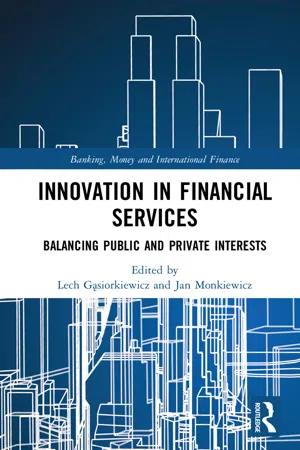
Innovation in Financial Services
Balancing Public and Private Interests
- 278 pages
- English
- ePUB (mobile friendly)
- Available on iOS & Android
Innovation in Financial Services
Balancing Public and Private Interests
About This Book
This book delves into the many innovative changes that the financial industry has undergone in recent years. The authors investigate these developments in a holistic manner and from a wide range of perspectives: both public and private, business and consumer, regulators and supervisors.
Initially, they set the framework of their analysis by discussing innovation cycles in financial services. Thereafter, they tackle the issue of financial innovations and their consequences for financial stability. They then review the new approaches to financial consumers' protection, which emerged in the aftermath of the global financial crisis. The authors underline the fact that this new approach is heavily influenced by the recent innovative drive in the financial industry. Next, they switch their attention to the public sector, examining the innovative processes in monetary policy and central banks, structural innovations in the supervisory models and systems, and they assess some specific supervisory challenges regarding blockchain and the application of mathematics in the supervisory capacity. Additionally, the book examines a range of issues related to the private sector, such as recent developments regarding risk transferring mechanisms on the financial market, artificial intelligence and natural language processing for regulatory filings, the development of process management in insurance companies and other innovative products on the market. Finally, Innovation in Financial Services discusses how the digital transformation of the financial system impacts the interaction between the public and private sectors.
The book is intended for graduate and postgraduate level students, researchers, public sector officers, as well as financial sector practitioners.
Frequently asked questions
Part I
SYSTEMIC ISSUES
1
DIGITAL TRANSFORMATION OF THE FINANCIAL ECOSYSTEM
Interaction of private and public sector
1.1 Introduction
- 1 (RQ1) What are the current interactions of the public and private sector in the digital transformation?
- 2 (RQ2) How will the interactions of the public and private sector change in the future – what changes are expected and missing from the scientific and commercial discourse?
1.2 Financial ecosystem – description
- 1 Capital distribution – moving capital from entities with surplus to the ones with shortages
- 2 Monetary intermediation – enabling the flow of value in the form of cash and payment instruments between market participants involved in exchange, purchase or sale transactions
- 3 Supervision – monitoring and regulating monetary and capital balances and transfers, risks and financial results – across the life cycles of entities on the macro and micro levels
- 4 Public and legal control – organizing the cooperation and coexistence of the private and public sectors via measures that promote or discourage certain behaviors and participants
| Element | Sector | Sample representation |
|---|---|---|
| 1 Financial institutions | private, public | banks, exchanges, loan companies, insurance companies, funds, brokerage houses, clearing, rating agencies, intermediaries |
| 2 Financial markets | private, public | platforms enabling the flow of value between their participants, based on contractual agreements on debt, rates, currency, cash, goods, derivatives; linked to economic flows or speculative |
| 3 Financial instruments | private, public | carriers of value: loans, deposits, payments, futures and options, securities, fund units |
| 4 Legal and regulatory institutions | private, public | • public: financial supervision authority, securities and exchange commission, protection of deposits, competition, consumers, personal data • private: associations and guilds of financial institutions |
| 5 Budgetary and fiscal institutions and instruments | public | • institutions: ministry of finance and treasury, central and local governments • instruments: taxation, social security, subsidies |
| 6 A set of rules and practices for participation | private, public | • public: legal acts, general/sector recommendations, regulatory compliance control (e.g. abusive clauses), capital regulations • private: joint recommendations and cooperation agreements (e.g. anti-money-laundering), market protection (e.g. cybercrime prevention), supervisory negotiations, lobbying |
| 7 Technical and logistical infrastructure | private, public | • public and private: information systems, market participant information, order control, durable media, archiving, portals, tokens |
- 1 Organizations present in the financial system are similar to organisms – they consist of various organs and they group into populations of species, operating on various levels of the biome (Rothschild, 1990). Study of interdependencies between natural organisms can be used to understand the dynamics of relations in the financial system. As in nature, in the business practice we are dealing with mainstream institutions, as well as niche or...
Table of contents
- Cover
- Half Title
- Series
- Title
- Copyright
- Contents
- List of figures
- List of tables
- List of contributors
- Acknowledgements
- Introduction
- Part I Systemic issues
- Part II Public sector
- Part III Private sector
- Index